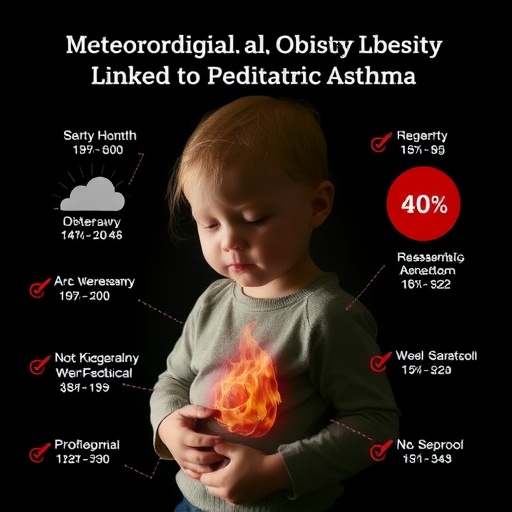In a groundbreaking investigation that intersects climatology, pediatric health, and epidemiology, researchers have unveiled compelling evidence linking meteorological variables and obesity to the frequency of asthma hospitalizations among children. The study, recently published in Pediatric Research, dives deep into the intricate dynamics between environmental stressors and physiological vulnerability, notably in the context of pediatric asthma exacerbations. This work shines a spotlight on whether overweight and obese children form a particularly susceptible demographic when faced with fluctuating weather conditions that historically correlate with respiratory distress.
Asthma, a chronic inflammatory disease of the airways, is a pivotal contributor to pediatric hospital admissions worldwide and represents a significant public health challenge. The multifaceted etiology involves genetic, immunological, and environmental components. Meteorological factors—such as temperature swings, humidity variation, and barometric pressure changes—have long been hypothesized to precipitate asthma attacks by influencing airway responsiveness or promoting allergen distribution. Compounding this environmental complexity is the high and rising prevalence of childhood obesity, which itself may alter respiratory physiology or inflammatory pathways.
The study’s methodological rigor is underscored by its large-scale, population-based design, incorporating robust datasets comprising pediatric asthma hospitalization records combined with detailed meteorological data over extended periods. This approach allowed for nuanced statistical analyses aimed at teasing apart the interactive effects of obesity and weather fluctuations on asthma exacerbations. Advanced regression models and potential confounder adjustments were employed to isolate these associations, offering unprecedented clarity to a previously nebulous relationship.
Results from the analysis elucidate a non-linear pattern in how certain meteorological variables correlate with increased risk of hospitalization, an association markedly amplified in overweight and obese children. For instance, abrupt drops in temperature or spikes in humidity were consistently linked to a surge in asthma admissions, particularly in those with higher body mass indices (BMI). This interaction suggests a potentiated vulnerability where excess adipose tissue may exacerbate inflammatory responses or impair respiratory mechanics under environmental stress.
Further, the study reports compelling evidence that obese children experience disproportionate exacerbation severity and frequency in the wake of adverse meteorological events. This finding aligns with emerging literature implicating obesity-related systemic inflammation and altered lung function as critical factors heightening susceptibility to external triggers. The data also hint at socio-economic and urban-rural gradients influencing exposure levels to detrimental weather conditions, accentuating disparities in pediatric asthma outcomes.
From a mechanistic standpoint, the intertwined effects of meteorological stressors and obesity on airway pathophysiology underscore a complex milieu in pediatric asthma. Cold air exposure, known to induce bronchoconstriction via vagal nerve stimulation, may be further aggravated by obesity-associated hypoventilation or reduced chest wall compliance. Similarly, increased humidity fosters mold and dust mite proliferation, which are potent aeroallergens exacerbating airway inflammation. The heightened baseline inflammation and immune dysregulation observed in obesity could amplify this allergenic burden, culminating in more severe clinical presentations.
This intersectionality has profound implications for clinical management and public health policy. Identifying obese children as a high-risk group in periods of unfavorable meteorological conditions enables more targeted preventive measures, ranging from anticipatory medication adjustments to enhanced surveillance. Moreover, public health advisories could integrate weather forecasts with obesity prevalence data to optimize resource allocation and community interventions.
The research team also discusses innovative statistical modeling techniques adapted to account for spatial heterogeneity and temporal autocorrelation inherent in meteorological and health outcome data. By integrating environmental sensors, electronic health records, and demographic variables, the study presents a sophisticated framework for predicting and mitigating asthma exacerbations. Such approaches signal a paradigm shift towards personalized medicine and precision public health in pediatric respiratory illness.
Importantly, the authors advocate for interdisciplinary collaboration, emphasizing that tackling the asthma epidemic necessitates joint efforts among climatologists, pediatricians, public health experts, and urban planners. Urban heat islands, air pollution, and climate change arenas intersect closely with their findings, highlighting that children’s respiratory health cannot be isolated from broader environmental challenges.
The implications extend beyond immediate hospitalization risks. Chronic asthma exacerbations contribute to long-term lung function decline and poor quality of life. The amplified vulnerability in overweight and obese children may portend a disproportionate burden of chronic respiratory disability as these cohorts age. Consequently, interventions addressing obesity alongside environmental mitigation constitute dual pillars for reducing pediatric asthma morbidity.
This study also underscores the importance of longitudinal monitoring to capture seasonal and interannual variability in meteorological factors influencing asthma risk. Given climate change trajectories, the frequency of extreme weather patterns is poised to shift, potentially exacerbating these observed effects. Continuous surveillance and adaptive public health strategies will thus be indispensable to protect vulnerable pediatric populations.
In synthesizing these findings, the authors stress the ethical urgency of integrating meteorological considerations into pediatric care paradigms and obesity prevention initiatives. Preventative efforts targeting childhood obesity, already critical for cardiovascular and metabolic health, emerge as crucial for respiratory resilience amidst mounting environmental pressures.
Moreover, the study catalyzes new avenues for research into the biological pathways whereby obesity modulates response to meteorological stimuli. Molecular investigations into adipokines, systemic inflammation mediators, and airway remodeling in the context of environmental exposures may unveil novel therapeutic targets to curb asthma exacerbations.
In conclusion, the pioneering research by Tran et al. offers an illuminating view into the confluence of meteorological stress and obesity in shaping pediatric asthma trajectories. By dissecting these complex interrelations with precision and nuance, it provides an invaluable evidence base steering clinical practice, public health frameworks, and future scientific inquiries towards mitigating one of childhood’s most burdensome respiratory conditions.
Subject of Research:
The interplay between meteorological factors, obesity, and pediatric asthma hospitalizations.
Article Title:
Associations of meteorological factors and obesity on pediatric asthma hospitalization.
Article References:
Tran, X.N., Lee, YL., Lin, YC. et al. Associations of meteorological factors and obesity on pediatric asthma hospitalization. Pediatr Res (2025). https://doi.org/10.1038/s41390-025-04500-4
Image Credits: AI Generated
DOI: https://doi.org/10.1038/s41390-025-04500-4
Tags: barometric pressure and asthma attackschildhood obesity and respiratory healthchronic inflammatory disease in childrenclimatology and pediatric healthenvironmental stressors and asthmaepidemiology of pediatric asthmahumidity and respiratory distressmeteorological factors and asthmaobesity’s impact on respiratory physiologypediatric asthma hospitalizationspublic health challenges in asthma managementtemperature and asthma exacerbations





